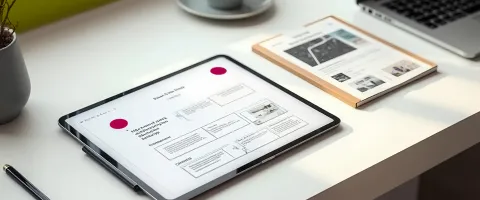Why your website brief matters
Your website is often the first impression of your business. A clear, focused brief helps your design agency understand what you need – and deliver a website that works for you. A good brief saves time, avoids miscommunication, and leads to better results.
Here’s how to write one that gets attention.
2. Set clear website goals
What do you want your new website to achieve? Common goals include:
- Increase online sales
- Get more enquiries or leads
- Improve brand visibility
- Share company updates and news
- Launch a new product or service
Tip: Prioritise your goals. Your designer needs to know what matters most.
4. List your must-have features
Here are common website features you might need:
- Blog or news section
- E-commerce functionality
- Booking or enquiry forms
- Interactive maps or location finders
- Content Management System (CMS)
- Integration with external api or system
Tip: Rank features by importance. If budget is limited, this helps prioritise.
5. Share examples you like (and don’t like)
- Include a few links to websites you admire – and explain why. Is it the layout? The colours? The tone of voice?
- Also include a few links to websites you don't like – and explain why.
- Finally, include any competitor sites you want to avoid mimicking.
Tip: The websites you like/dislike do not have to be from the same industry as yours, they can be from any industry.
6. Provide brand guidelines or design preferences
If you have branding guidelines, send them over. Remember to include:
- Logos and colour palettes
- Fonts and typography preferences
- Any imagery or icons you use
If you don’t have formal guidelines, describe your visual style (or sent samples of previous marketing material):
- Clean and modern?
- Friendly and approachable?
- Corporate and formal?
8. Set a realistic budget and timeline
Even if your budget isn’t fixed, give a ballpark figure or a budget range. This helps your agency propose the right solution for you.
For the timeline, don’t forget to include:
- Your preferred project start and end dates.
- Any deadlines (such as a product launch or event) that you need to meet.
10. Include contact details and next steps
Make it easy for the agency to respond to your proposal request:
- Your name and role.
- Contact number and email.
- Preferred method of communication.
- Deadline for proposals (if any).
Remember – Keep it short and focused
You don’t need a 20-page brief. One or two clear pages is often enough. Make sure it’s:
- Easy to read.
- Organised with headings and bullet points.
- Free of jargon or internal-only terms.
Designit builds websites that work for Irish businesses
At Designit, we’ve built websites for companies all across Ireland. We know what questions to ask – and how to turn a simple brief into a high-performing website. From brochure sites to eCommerce platforms, we can help your business:
- Define your goals.
- Improve your user experience.
- Optimise for Google.
- Create custom design and functionality.
Need help writing your brief? Talk to us today.
Let’s build something that works
A great website starts with a clear plan. Your brief sets the tone for the entire project.

Add new comment